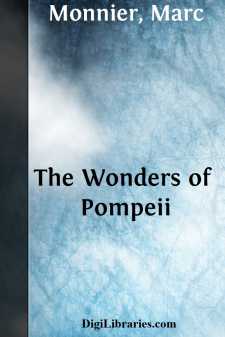Categories
- Antiques & Collectibles 13
- Architecture 36
- Art 48
- Bibles 22
- Biography & Autobiography 813
- Body, Mind & Spirit 142
- Business & Economics 28
- Children's Books 17
- Children's Fiction 14
- Computers 4
- Cooking 94
- Crafts & Hobbies 4
- Drama 346
- Education 46
- Family & Relationships 57
- Fiction 11829
- Games 19
- Gardening 17
- Health & Fitness 34
- History 1377
- House & Home 1
- Humor 147
- Juvenile Fiction 1873
- Juvenile Nonfiction 202
- Language Arts & Disciplines 88
- Law 16
- Literary Collections 686
- Literary Criticism 179
- Mathematics 13
- Medical 41
- Music 40
- Nature 179
- Non-Classifiable 1768
- Performing Arts 7
- Periodicals 1453
- Philosophy 64
- Photography 2
- Poetry 896
- Political Science 203
- Psychology 42
- Reference 154
- Religion 513
- Science 126
- Self-Help 84
- Social Science 81
- Sports & Recreation 34
- Study Aids 3
- Technology & Engineering 59
- Transportation 23
- Travel 463
- True Crime 29
The Wonders of Pompeii
by: Marc Monnier
Categories:
Description:
Excerpt
I.
THE EXHUMED CITY.
The Antique Landscape—The History of Pompeii Before and After its Destruction.—How it was Buried and Exhumed.—Winkelmann as a Prophet.—The Excavations in the Reign of Charles III., of Murat, and of Ferdinand.—The Excavations as they now are.—Signor Fiorelli.—Appearance of the Ruins.—What is and What is not Found There.
A railroad runs from Naples to Pompeii. Are you alone? The trip occupies one hour, and you have just time enough to read what follows, pausing once in a while to glance at Vesuvius and the sea; the clear, bright waters hemmed in by the gentle curve of the promontories; a bluish coast that approaches and becomes green; a green coast that withdraws into the distance and becomes blue; Castellamare looming up, and Naples receding. All these lines and colors existed too at the time when Pompeii was destroyed: the island of Prochyta, the cities of Baiæ, of Bauli, of Neapolis, and of Surrentum bore the names that they retain. Portici was called Herculaneum; Torre dell'Annunziata was called Oplontes; Castellamare, Stabiæ; Misenum and Minerva designated the two extremities of the gulf. However, Vesuvius was not what it has become; fertile and wooded almost to the summit, covered with orchards and vines, it must have resembled the picturesque heights of Monte San Angelo, toward which we are rolling. The summit alone, honeycombed with caverns and covered with black stones, betrayed to the learned a volcano "long extinct." It was to blaze out again, however, in a terrible eruption; and, since then, it has constantly flamed and smoked, menacing the ruins it has made and the new cities that brave it, calmly reposing at its feet.
What do you expect to find at Pompeii? At a distance, its antiquity seems enormous, and the word "ruins" awakens colossal conceptions in the excited fancy of the traveller. But, be not self-deceived; that is the first rule in knocking about over the world. Pompeii was a small city of only thirty thousand souls; something like what Geneva was thirty years ago. Like Geneva, too, it was marvellously situated—in the depth of a picturesque valley between mountains shutting in the horizon on one side, at a few steps from the sea and from a streamlet, once a river, which plunges into it—and by its charming site attracted personages of distinction, although it was peopled chiefly with merchants and others in easy circumstances; shrewd, prudent folk, and probably honest and clever enough, as well. The etymologists, after having exhausted, in their lexicons, all the words that chime in sound with Pompeii, have, at length, agreed in deriving the name from a Greek verb which signifies to send, to transport, and hence they conclude that many of the Pompeians were engaged in exportation, or perhaps, were emigrants sent from a distance to form a colony. Yet these opinions are but conjectures, and it is useless to dwell on them.
All that can be positively stated is that the city was the entrepôt of the trade of Nola, Nocera, and Atella....


